

Compact Muon Solenoid
LHC, CERN
| CMS-PAS-B2G-17-004 | ||
| Search for a heavy resonance decaying into a vector boson and a Higgs boson in semileptonic final states at $\sqrt{s}= $ 13 TeV | ||
| CMS Collaboration | ||
| March 2018 | ||
| Abstract: A search for heavy resonances decaying into a vector boson and the standard model Higgs boson is presented, in final states containing b quark-antiquark pairs from the decay of the Higgs boson and leptons (electrons and muons) or missing transverse momentum, because of undetected neutrinos, from the decay of the vector bosons. The analysis is performed using a data sample corresponding to an integrated luminosity of 35.9 fb$^{-1}$ collected in 2016 by the CMS experiment at the CERN LHC from proton-proton collisions at a center-of-mass energy of 13 TeV. The data are found to be consistent with the background expectations. Exclusion limits are set in the context of spin-1 heavy vector resonances and spin-0 two Higgs doublet models, also including the presence of dark matter. In a model with heavy vector triplet, W' and Z' resonances with a degenerate mass smaller than 2.9 TeV are excluded at 95% confidence level if the couplings to the standard model bosons dominate. | ||
|
Links:
CDS record (PDF) ;
inSPIRE record ;
CADI line (restricted) ;
These preliminary results are superseded in this paper, JHEP 11 (2018) 172. The superseded preliminary plots can be found here. |
||
| Figures | |
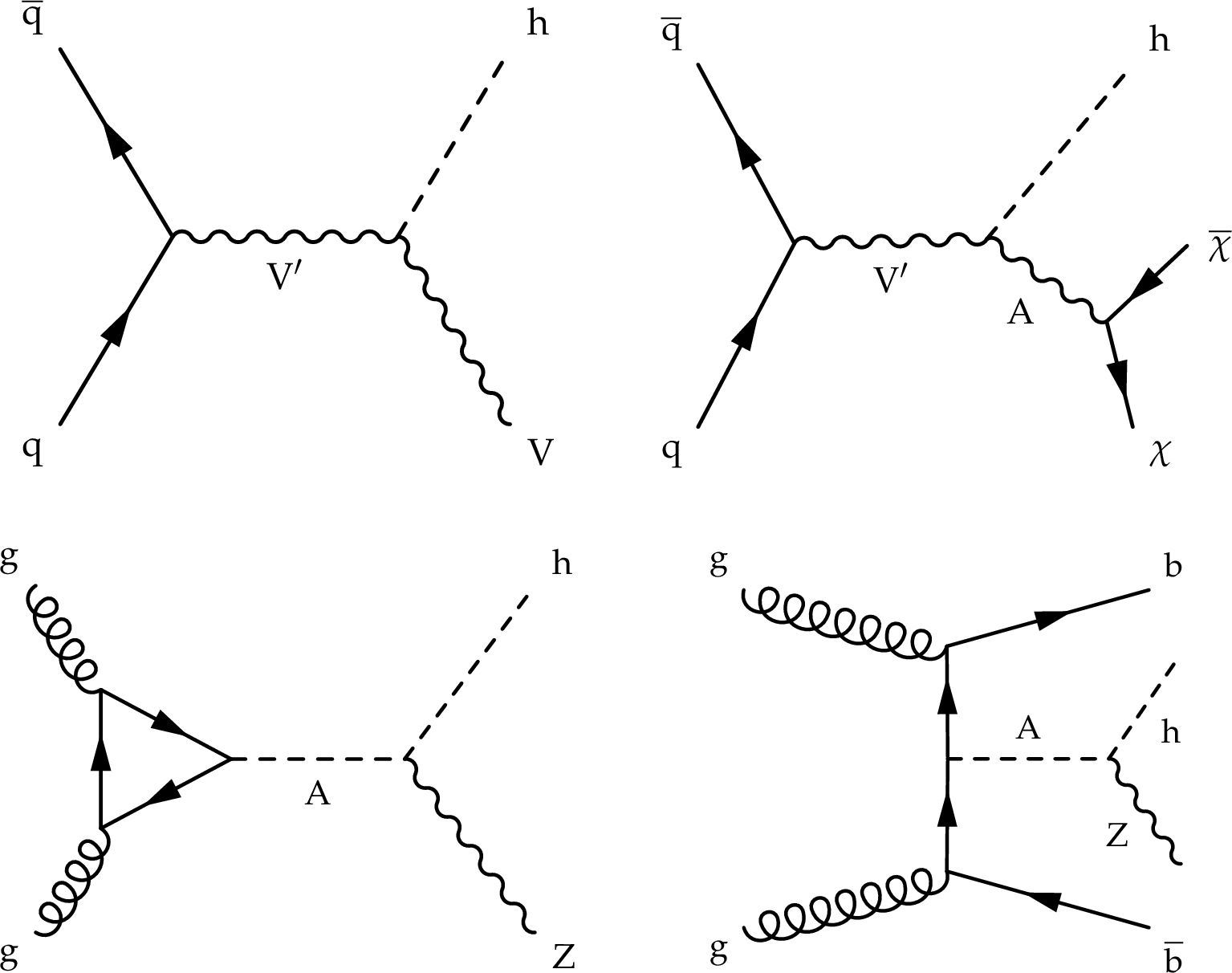
png pdf |
Figure 1:
Feynman diagrams of the considered processes: heavy spin-1 vector boson production and decay to a SM vector boson and a Higgs boson, as in the HVT framework (upper left); Z' boson that decays to a Higgs boson and a A boson, with the latter decaying into dark matter particles ($\chi \overline {\chi}$), predicted by the Z' -2HDM model (upper right); production within the 2HDM model of a pseudoscalar A boson through gluon-gluon fusion (lower left) and with accompanying b quarks (lower right). |

png pdf |
Figure 1-a:
Feynman diagram of the process: heavy spin-1 vector boson production and decay to a SM vector boson and a Higgs boson, as in the HVT framework. |
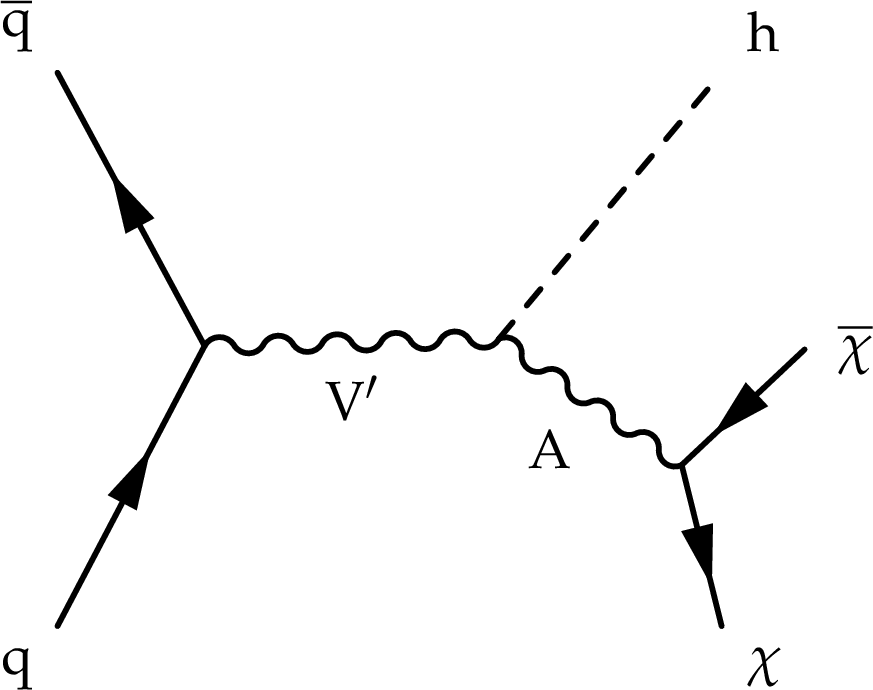
png pdf |
Figure 1-b:
Feynman diagram of the process: Z' boson that decays to a Higgs boson and a A boson, with the latter decaying into dark matter particles ($\chi \overline {\chi}$), predicted by the Z' -2HDM model. |

png pdf |
Figure 1-c:
Feynman diagram of the process: production within the 2HDM model of a pseudoscalar A boson through gluon-gluon fusion. |
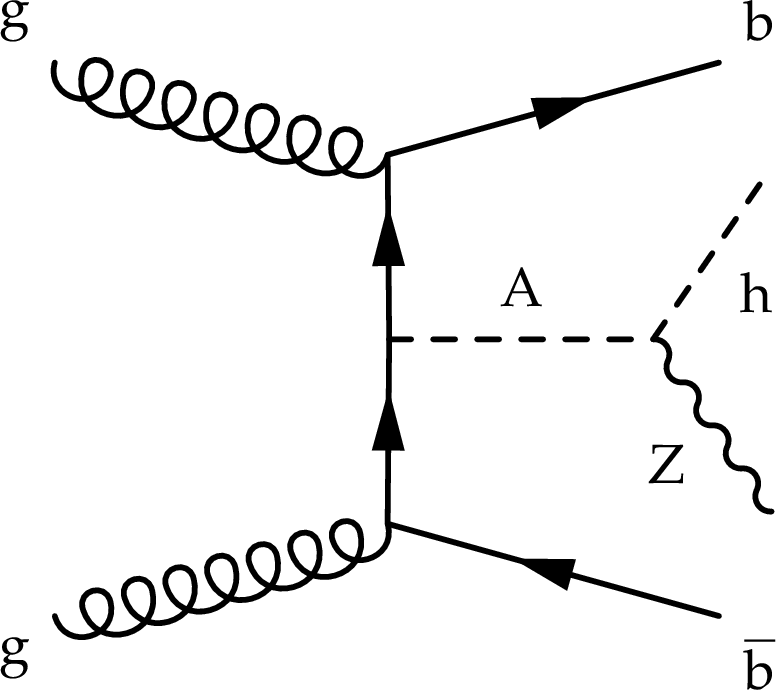
png pdf |
Figure 1-d:
Feynman diagram of the process: production within the 2HDM model of a pseudoscalar A boson with accompanying b quarks. |
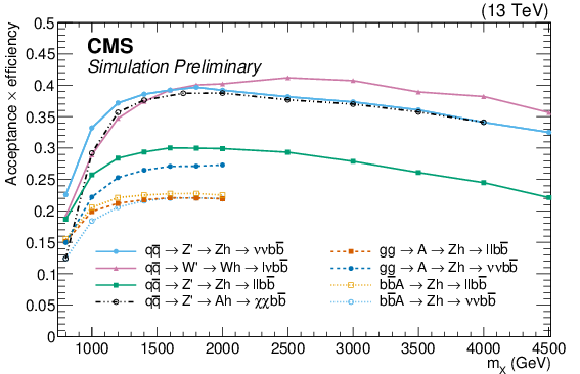
png pdf |
Figure 2:
Event selection efficiencies for various signal processes and for different assumed masses of the resonances $m_{{\mathrm {V}} '}$ or $ {m_{{\mathrm {A}}}} $. The dotted and solid lines indicate spin-0 and spin-1 resonances, respectively, in different production or decay modes. The dashed line represents the spin-1 resonance in the Z' -2HDM model with $ {m_{{\mathrm {A}}}} = $ 300 GeV. The efficiencies are derived by considering only the relevant decay modes of the vector bosons (electrons and muons, or $\tau $ leptons), and represent the sum of the efficiencies in the 1 and 2 b tag categories. |

png pdf |
Figure 3:
Soft drop PUPPI jet mass distribution of the leading AK8 jet in the 0$\ell $ (upper), 1$\ell $ (middle), and 2$\ell $ (lower) categories, and separately for the 1 (left) and 2 (right) b tagged subjet selections. The electron and muon categories are merged together. The shaded band represents the uncertainty from the fit to data in the jet mass sidebands. The observed data are indicated by black markers. The dashed vertical lines separate the lower (LSB) and upper (HSB) sidebands, the W and Z bosons mass region (VR), and the signal region (SR). The bottom panels report the pulls in each bin, $(N^\text {data}-N^\text {bkg})/\sigma $, where $\sigma $ is the statistical uncertainty in data, as given by the Garwood interval [71]. |
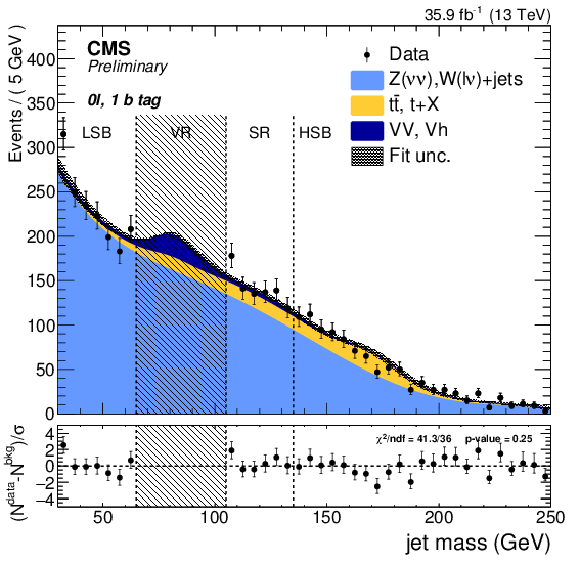
png pdf |
Figure 3-a:
Soft drop PUPPI jet mass distribution of the leading AK8 jet in the 0$\ell $ category, and separately for the 1 b tagged subjet selections. The electron and muon categories are merged together. The shaded band represents the uncertainty from the fit to data in the jet mass sidebands. The observed data are indicated by black markers. The dashed vertical lines separate the lower (LSB) and upper (HSB) sidebands, the W and Z bosons mass region (VR), and the signal region (SR). The bottom panel reports the pulls in each bin, $(N^\text {data}-N^\text {bkg})/\sigma $, where $\sigma $ is the statistical uncertainty in data, as given by the Garwood interval [71]. |
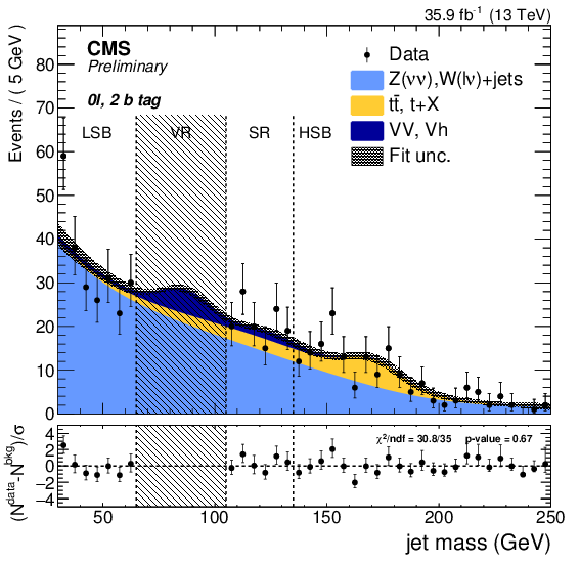
png pdf |
Figure 3-b:
Soft drop PUPPI jet mass distribution of the leading AK8 jet in the 0$\ell $ category, and separately for the 2 b tagged subjet selections. The electron and muon categories are merged together. The shaded band represents the uncertainty from the fit to data in the jet mass sidebands. The observed data are indicated by black markers. The dashed vertical lines separate the lower (LSB) and upper (HSB) sidebands, the W and Z bosons mass region (VR), and the signal region (SR). The bottom panel reports the pulls in each bin, $(N^\text {data}-N^\text {bkg})/\sigma $, where $\sigma $ is the statistical uncertainty in data, as given by the Garwood interval [71]. |

png pdf |
Figure 3-c:
Soft drop PUPPI jet mass distribution of the leading AK8 jet in the 1$\ell $ category, and separately for the 1 b tagged subjet selections. The electron and muon categories are merged together. The shaded band represents the uncertainty from the fit to data in the jet mass sidebands. The observed data are indicated by black markers. The dashed vertical lines separate the lower (LSB) and upper (HSB) sidebands, the W and Z bosons mass region (VR), and the signal region (SR). The bottom panel reports the pulls in each bin, $(N^\text {data}-N^\text {bkg})/\sigma $, where $\sigma $ is the statistical uncertainty in data, as given by the Garwood interval [71]. |

png pdf |
Figure 3-d:
Soft drop PUPPI jet mass distribution of the leading AK8 jet in the 1$\ell $ category, and separately for the 2 b tagged subjet selections. The electron and muon categories are merged together. The shaded band represents the uncertainty from the fit to data in the jet mass sidebands. The observed data are indicated by black markers. The dashed vertical lines separate the lower (LSB) and upper (HSB) sidebands, the W and Z bosons mass region (VR), and the signal region (SR). The bottom panel reports the pulls in each bin, $(N^\text {data}-N^\text {bkg})/\sigma $, where $\sigma $ is the statistical uncertainty in data, as given by the Garwood interval [71]. |

png pdf |
Figure 3-e:
Soft drop PUPPI jet mass distribution of the leading AK8 jet in the 2$\ell $ category, and separately for the 1 b tagged subjet selections. The electron and muon categories are merged together. The shaded band represents the uncertainty from the fit to data in the jet mass sidebands. The observed data are indicated by black markers. The dashed vertical lines separate the lower (LSB) and upper (HSB) sidebands, the W and Z bosons mass region (VR), and the signal region (SR). The bottom panel reports the pulls in each bin, $(N^\text {data}-N^\text {bkg})/\sigma $, where $\sigma $ is the statistical uncertainty in data, as given by the Garwood interval [71]. |

png pdf |
Figure 3-f:
Soft drop PUPPI jet mass distribution of the leading AK8 jet in the 2$\ell $ category, and separately for the 2 b tagged subjet selections. The electron and muon categories are merged together. The shaded band represents the uncertainty from the fit to data in the jet mass sidebands. The observed data are indicated by black markers. The dashed vertical lines separate the lower (LSB) and upper (HSB) sidebands, the W and Z bosons mass region (VR), and the signal region (SR). The bottom panel reports the pulls in each bin, $(N^\text {data}-N^\text {bkg})/\sigma $, where $\sigma $ is the statistical uncertainty in data, as given by the Garwood interval [71]. |
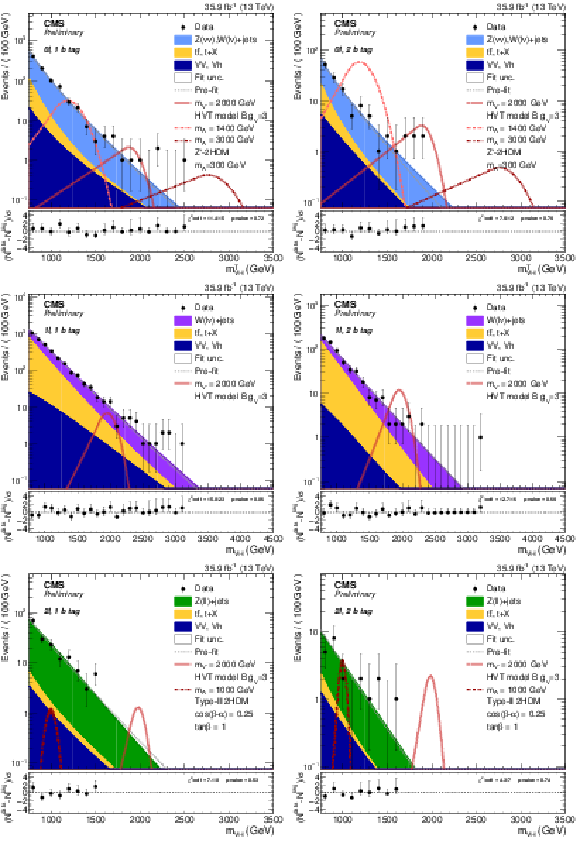
png pdf |
Figure 4:
Resonance candidate mass $ {m_{{\mathrm {V}} {\mathrm {h}}}} $ and transverse mass $ {m_{{\mathrm {V}} {\mathrm {h}}}^\mathrm {T}} $ distributions in the 0$\ell $ (upper), 1$\ell $ (middle), and 2$\ell $ (lower) categories, and separately for the 1 (left) and 2 (right) b tagged subjet selections. Electron and muon categories are merged together. The expected background events are shown with the filled area, and the shaded band represents the total background uncertainty. The observed data are indicated by black markers, and the potential contribution of a resonance produced in the context of the HVT model B with $ {g_\text {V}} =$ 3, or a Z' -2HDM signal with $ {m_{{\mathrm {A}}}} = $ 300 GeV, $m_\chi = $ 100 GeV, and $g_{\mathrm{Z'}}=$ 0.8, are shown as dotted red lines. The bottom panels report the pulls in each bin, $(N^\text {data}-N^\text {bkg})/\sigma $, where $\sigma $ is the statistical uncertainty in data, as given by the Garwood interval [71]. |

png pdf |
Figure 4-a:
Resonance candidate mass $ {m_{{\mathrm {V}} {\mathrm {h}}}} $ and transverse mass $ {m_{{\mathrm {V}} {\mathrm {h}}}^\mathrm {T}} $ distributions in the 0$\ell $ category, and separately for the 1 b tagged subjet selections. Electron and muon categories are merged together. The expected background events are shown with the filled area, and the shaded band represents the total background uncertainty. The observed data are indicated by black markers, and the potential contribution of a resonance produced in the context of the HVT model B with $ {g_\text {V}} =$ 3, or a Z' -2HDM signal with $ {m_{{\mathrm {A}}}} = $ 300 GeV, $m_\chi = $ 100 GeV, and $g_{\mathrm{Z'}}=$ 0.8, are shown as dotted red lines. The bottom panel reports the pulls in each bin, $(N^\text {data}-N^\text {bkg})/\sigma $, where $\sigma $ is the statistical uncertainty in data, as given by the Garwood interval [71]. |

png pdf |
Figure 4-b:
Resonance candidate mass $ {m_{{\mathrm {V}} {\mathrm {h}}}} $ and transverse mass $ {m_{{\mathrm {V}} {\mathrm {h}}}^\mathrm {T}} $ distributions in the 0$\ell $ category, and separately for the 2 b tagged subjet selections. Electron and muon categories are merged together. The expected background events are shown with the filled area, and the shaded band represents the total background uncertainty. The observed data are indicated by black markers, and the potential contribution of a resonance produced in the context of the HVT model B with $ {g_\text {V}} =$ 3, or a Z' -2HDM signal with $ {m_{{\mathrm {A}}}} = $ 300 GeV, $m_\chi = $ 100 GeV, and $g_{\mathrm{Z'}}=$ 0.8, are shown as dotted red lines. The bottom panel reports the pulls in each bin, $(N^\text {data}-N^\text {bkg})/\sigma $, where $\sigma $ is the statistical uncertainty in data, as given by the Garwood interval [71]. |

png pdf |
Figure 4-c:
Resonance candidate mass $ {m_{{\mathrm {V}} {\mathrm {h}}}} $ and transverse mass $ {m_{{\mathrm {V}} {\mathrm {h}}}^\mathrm {T}} $ distributions in the 1$\ell $ category, and separately for the 1 b tagged subjet selections. Electron and muon categories are merged together. The expected background events are shown with the filled area, and the shaded band represents the total background uncertainty. The observed data are indicated by black markers, and the potential contribution of a resonance produced in the context of the HVT model B with $ {g_\text {V}} =$ 3, or a Z' -2HDM signal with $ {m_{{\mathrm {A}}}} = $ 300 GeV, $m_\chi = $ 100 GeV, and $g_{\mathrm{Z'}}=$ 0.8, are shown as dotted red lines. The bottom panel reports the pulls in each bin, $(N^\text {data}-N^\text {bkg})/\sigma $, where $\sigma $ is the statistical uncertainty in data, as given by the Garwood interval [71]. |

png pdf |
Figure 4-d:
Resonance candidate mass $ {m_{{\mathrm {V}} {\mathrm {h}}}} $ and transverse mass $ {m_{{\mathrm {V}} {\mathrm {h}}}^\mathrm {T}} $ distributions in the 1$\ell $ category, and separately for the 2 b tagged subjet selections. Electron and muon categories are merged together. The expected background events are shown with the filled area, and the shaded band represents the total background uncertainty. The observed data are indicated by black markers, and the potential contribution of a resonance produced in the context of the HVT model B with $ {g_\text {V}} =$ 3, or a Z' -2HDM signal with $ {m_{{\mathrm {A}}}} = $ 300 GeV, $m_\chi = $ 100 GeV, and $g_{\mathrm{Z'}}=$ 0.8, are shown as dotted red lines. The bottom panel reports the pulls in each bin, $(N^\text {data}-N^\text {bkg})/\sigma $, where $\sigma $ is the statistical uncertainty in data, as given by the Garwood interval [71]. |
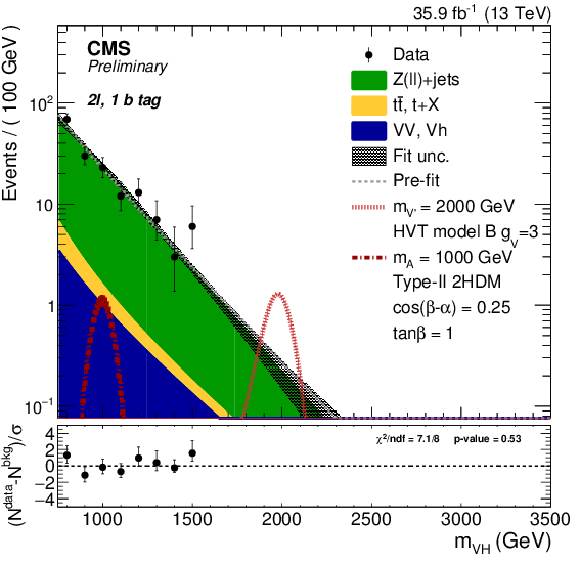
png pdf |
Figure 4-e:
Resonance candidate mass $ {m_{{\mathrm {V}} {\mathrm {h}}}} $ and transverse mass $ {m_{{\mathrm {V}} {\mathrm {h}}}^\mathrm {T}} $ distributions in the 2$\ell $ category, and separately for the 1 b tagged subjet selections. Electron and muon categories are merged together. The expected background events are shown with the filled area, and the shaded band represents the total background uncertainty. The observed data are indicated by black markers, and the potential contribution of a resonance produced in the context of the HVT model B with $ {g_\text {V}} =$ 3, or a Z' -2HDM signal with $ {m_{{\mathrm {A}}}} = $ 300 GeV, $m_\chi = $ 100 GeV, and $g_{\mathrm{Z'}}=$ 0.8, are shown as dotted red lines. The bottom panel reports the pulls in each bin, $(N^\text {data}-N^\text {bkg})/\sigma $, where $\sigma $ is the statistical uncertainty in data, as given by the Garwood interval [71]. |

png pdf |
Figure 4-f:
Resonance candidate mass $ {m_{{\mathrm {V}} {\mathrm {h}}}} $ and transverse mass $ {m_{{\mathrm {V}} {\mathrm {h}}}^\mathrm {T}} $ distributions in the 2$\ell $ category, and separately for the 2 b tagged subjet selections. Electron and muon categories are merged together. The expected background events are shown with the filled area, and the shaded band represents the total background uncertainty. The observed data are indicated by black markers, and the potential contribution of a resonance produced in the context of the HVT model B with $ {g_\text {V}} =$ 3, or a Z' -2HDM signal with $ {m_{{\mathrm {A}}}} = $ 300 GeV, $m_\chi = $ 100 GeV, and $g_{\mathrm{Z'}}=$ 0.8, are shown as dotted red lines. The bottom panel reports the pulls in each bin, $(N^\text {data}-N^\text {bkg})/\sigma $, where $\sigma $ is the statistical uncertainty in data, as given by the Garwood interval [71]. |

png pdf |
Figure 5:
Observed and expected 95% CL upper limits on $\sigma ({\mathrm {W}} ') + {\mathcal {B}}({\mathrm {W}} '\to {\mathrm {W}} {\mathrm {h}}) + {\mathcal {B}}({{\mathrm {h}} \to {\mathrm{b} \mathrm{\bar{b}}}})$ (left) and $\sigma (\mathrm{Z'}) + {\mathcal {B}}(\mathrm{Z'} \to {\mathrm{Z}} {\mathrm {h}}) + {\mathcal {B}}({{\mathrm {h}} \to {\mathrm{b} \mathrm{\bar{b}}}})$ (right) for various mass hypotheses of a single narrow spin-1 resonance. The inner green and outer yellow bands represent the ${\pm}1$ and ${\pm}2$ standard deviation (std.) variation on the expected limits. The solid curves and their shaded areas correspond to the product of the cross sections and the branching fractions predicted by the HVT model A and B and the relative uncertainties. |

png pdf |
Figure 5-a:
Observed and expected 95% CL upper limits on $\sigma ({\mathrm {W}} ') + {\mathcal {B}}({\mathrm {W}} '\to {\mathrm {W}} {\mathrm {h}}) + {\mathcal {B}}({{\mathrm {h}} \to {\mathrm{b} \mathrm{\bar{b}}}})$ for various mass hypotheses of a single narrow spin-1 resonance. The inner green and outer yellow bands represent the ${\pm}$1 and ${\pm}2$ standard deviation (std.) variation on the expected limits. The solid curves and their shaded areas correspond to the product of the cross sections and the branching fractions predicted by the HVT model A and B and the relative uncertainties. |
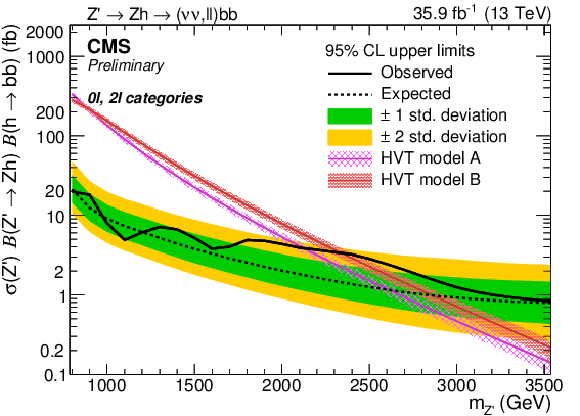
png pdf |
Figure 5-b:
Observed and expected 95% CL upper limits on $\sigma (\mathrm{Z'}) + {\mathcal {B}}(\mathrm{Z'} \to {\mathrm{Z}} {\mathrm {h}}) + {\mathcal {B}}({{\mathrm {h}} \to {\mathrm{b} \mathrm{\bar{b}}}})$ for various mass hypotheses of a single narrow spin-1 resonance. The inner green and outer yellow bands represent the ${\pm}$1 and ${\pm}2$ standard deviation (std.) variation on the expected limits. The solid curves and their shaded areas correspond to the product of the cross sections and the branching fractions predicted by the HVT model A and B and the relative uncertainties. |
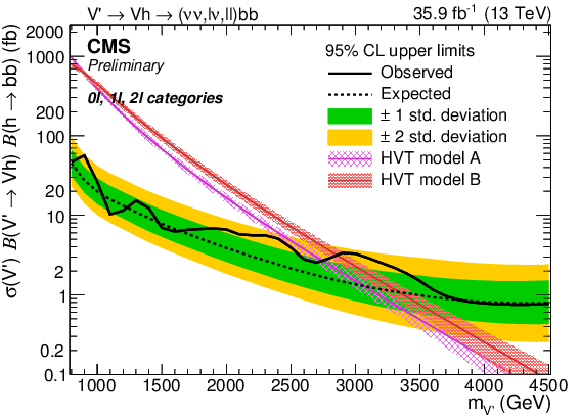
png pdf |
Figure 6:
Observed and expected 95% CL upper limit with the ${\pm}$1 and ${\pm}2$ standard deviation uncertainty bands on $\sigma ({\mathrm {X}}) + {\mathcal {B}}({\mathrm {X}} \to {{\mathrm {V}} {\mathrm {h}}}) + {\mathcal {B}}({{\mathrm {h}} \to {\mathrm{b} \mathrm{\bar{b}}}})$ as a function of the HVT triplet mass, for the combination of all the considered channels. The solid curves and their shaded areas correspond to the cross sections predicted by the HVT model A and B and the relative uncertainties. |

png pdf |
Figure 7:
Observed exclusion limits in the HVT parameter plane $\left [ {g_\text {V}} {c_\text {H}}, \ g^2 {c_\text {F}} / {g_\text {V}} \right ]$ for three different resonance masses (1.5, 2.0, and 3.0 TeV). The benchmark scenarios corresponding to HVT model A and model B are represented by a purple cross and a red point. The gray shaded area corresponds to the region where the resonance natural width ($\Gamma _{{\mathrm {V}} '}$) is predicted to be larger than the typical experimental resolution (4%), and thus the narrow-width approximation is not fulfilled. |

png pdf |
Figure 8:
Observed and expected 95% CL upper limit with the ${\pm}$1 and ${\pm}2$ standard deviation bands on $\sigma ({\mathrm {A}}) + {\mathcal {B}}({\mathrm {A}} \to {\mathrm{Z}} {\mathrm {h}}) + {\mathcal {B}}({\mathrm {h}} \to {\mathrm{b} \mathrm{\bar{b}}})$ as a function of $ {m_{{\mathrm {A}}}} $ for the combination of the 0$\ell $ and 2$\ell $ channels. The solid line represent the exclusion for a spin-0 signal produced through gluon-gluon fusion, and dashed line represent the b quark associated production. The solid lines and their shaded area represent the corresponding values predicted by the Type-I and Type-II 2HDM model fixing the parameters $ \cos(\beta -\alpha) = $ 0.25 and $\tan\beta =$ 1 parameters. In this scenario, the b quark associated production is negligible, and the A is predominantly produced through gluon-gluon fusion. |
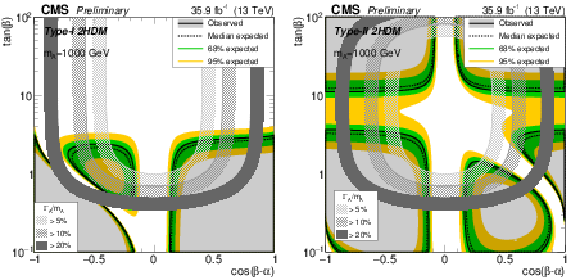
png pdf |
Figure 9:
Observed and expected exclusion limit for Type-I (left) and Type-II 2HDM models (right) in the [ $\tan\beta$, $\cos(\beta -\alpha)$ ] plane and assuming a fixed $ {m_{{\mathrm {A}}}} = $ 1 TeV. The light shaded areas identify regions with different resonance natural width (5%, 10%, 20% of the resonance mass). |
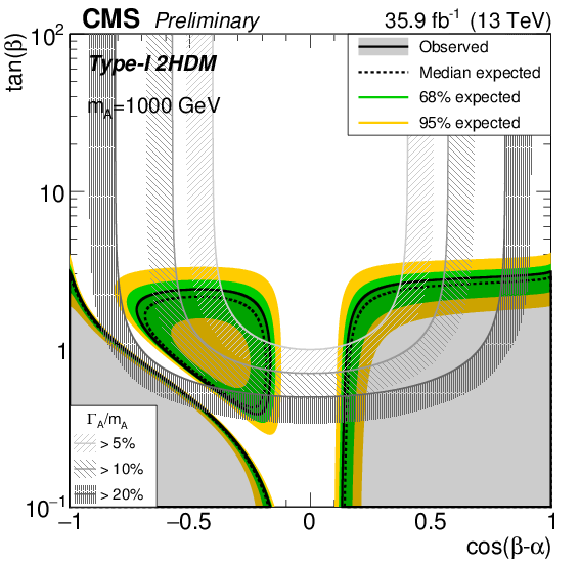
png pdf |
Figure 9-a:
Observed and expected exclusion limit for Type-I 2HDM models in the [ $\tan\beta$, $\cos(\beta -\alpha)$ ] plane and assuming a fixed $ {m_{{\mathrm {A}}}} = $ 1 TeV. The light shaded areas identify regions with different resonance natural width (5%, 10%, 20% of the resonance mass). |

png pdf |
Figure 9-b:
Observed and expected exclusion limit for Type-II 2HDM models in the [ $\tan\beta$, $\cos(\beta -\alpha)$ ] plane and assuming a fixed $ {m_{{\mathrm {A}}}} = $ 1 TeV. The light shaded areas identify regions with different resonance natural width (5%, 10%, 20% of the resonance mass). |

png pdf |
Figure 10:
Observed and expected exclusion on the parameter plane [$m_{\mathrm{Z'}}, m_ {\mathrm {A}} $]. The excluded region in the considered benchmark scenario ($g_{\mathrm{Z'}} = $ 0.8, $g_\chi = $ 1, $\tan\beta = $ 1, $m_\chi = $ 100 GeV, and $ {m_{{\mathrm {A}}}} = {m_{{\mathrm {H}}}} = {m_{{\mathrm {H}} ^\pm}} $) is represented by the shaded area. |
| Tables | |
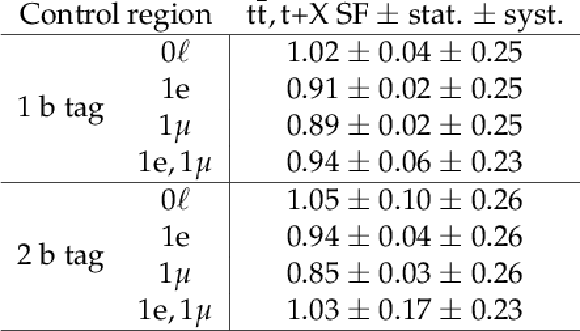
png pdf |
Table 1:
Scale factors (SF) derived to correct for the event yields of the $ {\mathrm{t} {}\mathrm{\bar{t}}} $ and $ \mathrm{t+X} $ backgrounds for different top quark control regions. The uncertainties because of the limited size of the data samples (stat.) and systematic effects (syst.), described in Sec. 7, are reported. |
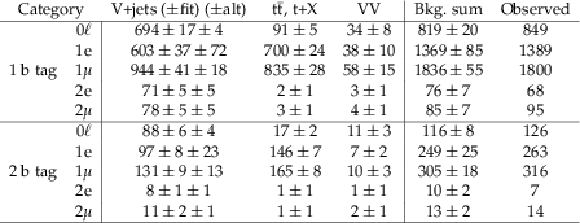
png pdf |
Table 2:
Expected and observed numbers of events in the signal regions, for all event categories. Three separate sources of uncertainty in the expected numbers are reported: the V+jets background uncertainty from the variation of the parameters used to model the $ {m_{\mathrm {j}}} $ distribution, taking into account their correlations (fit); the difference between the nominal and alternative function choice for the fit to $ {m_{\mathrm {j}}} $ (alt); the $ {\mathrm{t} {}\mathrm{\bar{t}}} $, $ \mathrm{t+X} $ uncertainties from the $ {m_{\mathrm {j}}} $ modeling, the statistical component of the top quark scale factor uncertainties, and the extrapolation uncertainty from the control regions to the SR; the VV normalization uncertainties relative to the $ {m_{\mathrm {j}}} $ modeling and the uncertainties affecting the normalization. A detailed description of the systematic uncertainties is provided in Sec. 7. |
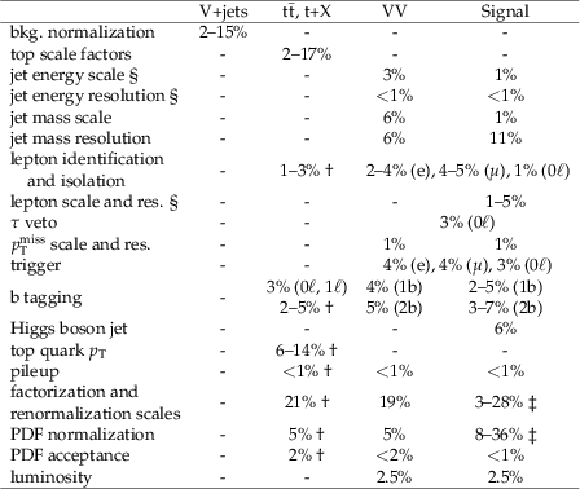
png pdf |
Table 3:
Summary of systematic uncertainties for the backgrounds and signal samples. The entries labeled with a "math-section" are also propagated to the shapes of the distributions. Uncertainties marked with $\dagger $ only affect the top quark scale factors. The uncertainties marked with $\ddagger $ have impact on the signal cross section. |
| Summary |
| A search for a resonance with mass between 800 and 4500 GeV, decaying to a standard model (SM) vector boson and a SM Higgs boson, is reported. The data sample was collected by the CMS experiment at $\sqrt{s} = $ 13 TeV, and corresponds to an integrated luminosity of 35.9 fb$^{-1}$. The final states contained the leptonic decays of the vector bosons, in events with zero, exactly one, and two electrons or muons. The standard model Higgs boson is reconstructed from its decay to b quark-antiquark pairs. Depending on the resonance mass, upper limits in the range 0.8-60 fb are set on the product of the cross sections and the branching fractions for the decay of the resonance into a Higgs and a vector boson, and for the decay of the Higgs boson into a pair of b quarks. In a triplet of narrow spin-1 resonances, vector bosons with a mass lower than 2.8 and 2.9 TeV are excluded in the benchmark scenarios A and B, respectively. Furthermore, the results of this search provide an exclusion in the two Higgs doublet model (2HDM) parameter space up to 2 TeV, which is a kinematic region previously unexplored by previous CMS searches, and a heavy pseudoscalar boson with mass lower than 1.1 TeV and 1.2 TeV is excluded in the ${\cos(\beta-\alpha)} = $ 0.25 and $\tan\beta= $ 1 scenario. A significant reduction of the allowed parameter space is also placed on the Z'-2HDM model that includes a dark matter candidate, excluding a Z' boson mass up to 3.2 TeV, and a pseudoscalar boson A up to 800 GeV in the considered benchmark scenario, placing the most stringent limits on this model to date. |
| References | ||||
| 1 | ATLAS Collaboration | Observation of a new particle in the search for the Standard Model Higgs boson with the ATLAS detector at the LHC | PLB 716 (2012) 1 | 1207.7214 |
| 2 | CMS Collaboration | Observation of a new boson at a mass of 125 GeV with the CMS experiment at the LHC | PLB 716 (2012) 30 | CMS-HIG-12-028 1207.7235 |
| 3 | CMS Collaboration | Observation of a new boson with mass near 125 GeV in pp collisions at $ \sqrt{s} = $ 7 and 8 TeV | JHEP 06 (2013) 081 | CMS-HIG-12-036 1303.4571 |
| 4 | ATLAS Collaboration | Measurement of the Higgs boson mass from the $ H\rightarrow{}\gamma{}\gamma{} $ and $ H\rightarrow{}Z{Z}^{*}\rightarrow{}4\ell{} $ channels in $ pp $ collisions at center-of-mass energies of 7 and 8~TeV with the ATLAS detector | PRD 90 (2014) 052004 | 1406.3827 |
| 5 | CMS Collaboration | Precise determination of the mass of the Higgs boson and tests of compatibility of its couplings with the standard model predictions using proton collisions at 7 and 8 TeV | EPJC 75 (2015) 212 | CMS-HIG-14-009 1412.8662 |
| 6 | CMS Collaboration | Evidence for the direct decay of the 125 GeV Higgs boson to fermions | NP 10 (2014) 557 | CMS-HIG-13-033 1401.6527 |
| 7 | ATLAS and CMS Collaborations | Combined measurement of the Higgs boson mass in $ pp $ collisions at $ \sqrt{s}= $ 7 and 8 TeV with the ATLAS and CMS experiments | PRL 114 (2015) 191803 | 1503.07589 |
| 8 | G. F. Giudice | Naturally Speaking: The Naturalness Criterion and Physics at the LHC'', , To be published in the book ``LHC Perspectives | edited by G. Kane and A. Pierce | 0801.2562 |
| 9 | C. Grojean, E. Salvioni, and R. Torre | A weakly constrained W$ ' $ at the early LHC | JHEP 07 (2011) 002 | 1103.2761 |
| 10 | V. D. Barger, W.-Y. Keung, and E. Ma | A gauge model with light $ W $ and $ Z $ bosons | PRD 22 (1980) 727 | |
| 11 | E. Salvioni, G. Villadoro, and F. Zwirner | Minimal Z' models: present bounds and early LHC reach | JHEP 09 (2009) 068 | 0909.1320 |
| 12 | R. Contino, D. Pappadopulo, D. Marzocca, and R. Rattazzi | On the effect of resonances in composite Higgs phenomenology | JHEP 10 (2011) 081 | 1109.1570 |
| 13 | D. Marzocca, M. Serone, and J. Shu | General composite Higgs models | JHEP 08 (2012) 13 | 1205.0770 |
| 14 | B. Bellazzini, C. Csaki, and J. Serra | Composite Higgses | EPJC 74 (2014) 2766 | 1401.2457 |
| 15 | K. Lane and L. Pritchett | The light composite Higgs boson in strong extended technicolor | JHEP 06 (2017) 140 | 1604.07085 |
| 16 | T. Han, H. E. Logan, B. McElrath, and L.-T. Wang | Phenomenology of the little Higgs model | PRD 67 (2003) 095004 | hep-ph/0301040 |
| 17 | M. Schmaltz and D. Tucker-Smith | Little Higgs theories | Ann. Rev. Nucl. Part. Sci. 55 (2005) 229 | hep-ph/0502182 |
| 18 | M. Perelstein | Little Higgs models and their phenomenology | Prog. Part. NP 58 (2007) 247 | hep-ph/0512128 |
| 19 | D. Pappadopulo, A. Thamm, R. Torre, and A. Wulzer | Heavy vector triplets: bridging theory and data | JHEP 09 (2014) 60 | 1402.4431 |
| 20 | G. C. Branco et al. | Theory and phenomenology of two-Higgs-doublet models | Phys. Rep. 516 (2012) 1 | 1106.0034 |
| 21 | A. Berlin, T. Lin, and L.-T. Wang | Mono-Higgs Detection of Dark Matter at the LHC | JHEP 06 (2014) 078 | 1402.7074 |
| 22 | L. Carpenter et al. | Mono-Higgs-boson: A new collider probe of dark matter | PRD 89 (2014) 075017 | 1312.2592 |
| 23 | ATLAS Collaboration | Search for a new resonance decaying to a W or Z boson and a Higgs boson in the $ \ell \ell / \ell \nu / \nu \nu + b \bar{b} $ final states with the ATLAS detector | EPJC 75 (2015) 263 | 1503.08089 |
| 24 | CMS Collaboration | Search for narrow high-mass resonances in proton-proton collisions at $ \sqrt{s} = $ 8 TeV decaying to a Z and a Higgs boson | PLB 748 (2015) 255 | CMS-EXO-13-007 1502.04994 |
| 25 | CMS Collaboration | Search for massive resonances decaying into WW, WZ, ZZ, qW, and qZ with dijet final states at sqrt(s) = 13 TeV | Submitted to \it PRD | CMS-B2G-17-001 1708.05379 |
| 26 | ATLAS Collaboration | Searches for heavy diboson resonances in $ pp $ collisions at $ \sqrt{s}= $ 13 TeV with the ATLAS detector | JHEP 09 (2016) 173 | 1606.04833 |
| 27 | CMS Collaboration | Search for heavy resonances decaying into a vector boson and a Higgs boson in final states with charged leptons, neutrinos, and b quarks | PLB 768 (2017) 137 | CMS-B2G-16-003 1610.08066 |
| 28 | ATLAS Collaboration | Search for heavy resonances decaying into a $ W $ or $ Z $ boson and a Higgs boson in final states with leptons and $ b $-jets in 36 fb$ ^{-1} $ of $ \sqrt s = 13 TeV pp $ collisions with the ATLAS detector | Submitted to JHEP | 1712.06518 |
| 29 | ATLAS Collaboration | Search for new resonances decaying to a $ W $ or $ Z $ boson and a Higgs boson in the $ \ell^+ \ell^- b\bar b $, $ \ell \nu b\bar b $, and $ \nu\bar{\nu} b\bar b $ channels with $ pp $ collisions at $ \sqrt s = $ 13 TeV with the ATLAS detector | PLB 765 (2016) 32 | 1607.05621 |
| 30 | CMS Collaboration | Search for heavy resonances that decay into a vector boson and a Higgs boson in hadronic final states at $ \sqrt{s} = $ 13 TeV | EPJC 77 (2017) 636 | CMS-B2G-17-002 1707.01303 |
| 31 | ATLAS Collaboration | Search for heavy resonances decaying to a $ W $ or $ Z $ boson and a Higgs boson in the $ q\bar{q}^{(\prime)}b\bar{b} $ final state in $ pp $ collisions at $ \sqrt{s} = $ 13 TeV with the ATLAS detector | Submitted to \it PLB | 1707.06958 |
| 32 | CMS Collaboration | Search for a pseudoscalar boson decaying into a Z boson and the 125 GeV Higgs boson in $ \ell^+\ell^- b\overline{b} $ final states | PLB 748 (2015) 221 | CMS-HIG-14-011 1504.04710 |
| 33 | CMS Collaboration | Search for massive WH resonances decaying into the $ \ell \nu\mathrm{b \overline{b}} $ final state at $ \sqrt{s}= $ 8 TeV | EPJC 76 (2016) 1 | CMS-EXO-14-010 1601.06431 |
| 34 | CMS Collaboration | Search for associated production of dark matter with a Higgs boson decaying to $ b\bar{b} $ or $ \gamma\gamma $ at $ \sqrt{s} = $ 13 TeV | Submitted to \it JHEP | CMS-EXO-16-012 1703.05236 |
| 35 | ATLAS Collaboration | Search for Dark Matter Produced in Association with a Higgs Boson Decaying to $ b\bar b $ using 36 fb$ ^{-1} $ of $ pp $ collisions at $ \sqrt s= $ 13 TeV with the ATLAS Detector | PRL 119 (2017) 181804 | 1707.01302 |
| 36 | LHC Higgs Cross Section Working Group | Handbook of LHC Higgs Cross Sections: 3. Higgs Properties | CERN-2013-004 (2013) | 1307.1347 |
| 37 | CMS Collaboration | The CMS experiment at the CERN LHC | JINST 3 (2008) S08004 | CMS-00-001 |
| 38 | CMS Collaboration | Description and performance of track and primary-vertex reconstruction with the CMS tracker | JINST 9 (2014) P10009 | CMS-TRK-11-001 1405.6569 |
| 39 | CMS Collaboration | Performance of CMS muon reconstruction in pp collision events at $ \sqrt{s}= $ 7 TeV | JINST 7 (2012) P10002 | CMS-MUO-10-004 1206.4071 |
| 40 | CMS Collaboration | The CMS trigger system | JINST 12 (2017) P01020 | CMS-TRG-12-001 1609.02366 |
| 41 | D. Abercrombie et al. | Dark Matter Benchmark Models for Early LHC Run-2 Searches: Report of the ATLAS/CMS Dark Matter Forum | 1507.00966 | |
| 42 | J. Alwall et al. | The automated computation of tree-level and next-to-leading order differential cross sections, and their matching to parton shower simulations | JHEP 07 (2014) 079 | 1405.0301 |
| 43 | Y. Li and F. Petriello | Combining QCD and electroweak corrections to dilepton production in FEWZ | PRD 86 (2012) 094034 | 1208.5967 |
| 44 | S. Kallweit et al. | NLO QCD+EW predictions for V+jets including off-shell vector-boson decays and multijet merging | JHEP 04 (2016) 021 | 1511.08692 |
| 45 | P. Nason | A new method for combining NLO QCD with shower Monte Carlo algorithms | JHEP 11 (2004) 040 | hep-ph/0409146 |
| 46 | S. Frixione, P. Nason, and C. Oleari | Matching NLO QCD computations with Parton Shower simulations: the POWHEG method | JHEP 11 (2007) 070 | 0709.2092 |
| 47 | S. Alioli, P. Nason, C. Oleari, and E. Re | A general framework for implementing NLO calculations in shower Monte Carlo programs: the POWHEG BOX | JHEP 06 (2010) 043 | 1002.2581 |
| 48 | M. Czakon and A. Mitov | Top++: A program for the calculation of the top-pair cross-section at hadron colliders | CPC 185 (2014) 2930 | 1112.5675 |
| 49 | CMS Collaboration | Measurement of differential cross sections for top quark pair production using the lepton+jets final state in proton-proton collisions at 13 TeV | PRD 95 (2017) 092001 | CMS-TOP-16-008 1610.04191 |
| 50 | R. Frederix and S. Frixione | Merging meets matching in MC@NLO | JHEP 12 (2012) 061 | 1209.6215 |
| 51 | NNPDF Collaboration | Parton distributions for the LHC Run II | JHEP 04 (2015) 040 | 1410.8849 |
| 52 | T. Sjostrand, S. Mrenna, and P. Skands | A brief introduction to PYTHIA 8.1 | CPC 178 (2008) 852 | 0710.3820 |
| 53 | T. Sjostrand, S. Mrenna, and P. Skands | PYTHIA 6.4 physics and manual | JHEP 05 (2006) 026 | hep-ph/0603175 |
| 54 | P. Skands, S. Carrazza, and J. Rojo | Tuning PYTHIA 8.1: the Monash 2013 Tune | EPJC 74 (2014) 3024 | 1404.5630 |
| 55 | CMS Collaboration | Event generator tunes obtained from underlying event and multiparton scattering measurements | EPJC 76 (2016) 155 | CMS-GEN-14-001 1512.00815 |
| 56 | CMS Collaboration | Investigations of the impact of the parton shower tuning in Pythia 8 in the modelling of $ \mathrm{t\overline{t}} $ at $ \sqrt{s}= $ 8 and 13 TeV | CMS-PAS-TOP-16-021 | CMS-PAS-TOP-16-021 |
| 57 | GEANT4 Collaboration | GEANT4---a simulation toolkit | NIMA 506 (2003) 250 | |
| 58 | CMS Collaboration | Particle-flow reconstruction and global event description with the cms detector | JINST 12 (2017) P10003 | CMS-PRF-14-001 1706.04965 |
| 59 | M. Cacciari, G. P. Salam, and G. Soyez | The anti-$ k_\text{t} $ jet clustering algorithm | JHEP 04 (2008) 063 | 0802.1189 |
| 60 | M. Cacciari, G. P. Salam, and G. Soyez | FastJet user manual | EPJC 72 (2012) 1896 | 1111.6097 |
| 61 | CMS Collaboration | Pileup removal algorithms | CMS-PAS-JME-14-001 | CMS-PAS-JME-14-001 |
| 62 | M. Cacciari, G. P. Salam, and G. Soyez | The catchment area of jets | JHEP 04 (2008) 005 | 0802.1188 |
| 63 | CMS Collaboration | Jet energy scale and resolution in the CMS experiment in pp collisions at 8 TeV | JINST 12 (2017) P02014 | CMS-JME-13-004 1607.03663 |
| 64 | D. Bertolini, P. Harris, M. Low, and N. Tran | Pileup per particle identification | JHEP 10 (2014) 59 | 1407.6013 |
| 65 | M. Dasgupta, A. Fregoso, S. Marzani, and G. P. Salam | Towards an understanding of jet substructure | JHEP 09 (2013) 029 | 1307.0007 |
| 66 | A. J. Larkoski, S. Marzani, G. Soyez, and J. Thaler | Soft drop | JHEP 05 (2014) 146 | 1402.2657 |
| 67 | CMS Collaboration | Jet algorithms performance in 13 TeV data | CMS-PAS-JME-16-003 | CMS-PAS-JME-16-003 |
| 68 | CMS Collaboration | Identification of heavy-flavour jets with the CMS detector in pp collisions at 13 TeV | Submitted to \it JINST | CMS-BTV-16-002 1712.07158 |
| 69 | CMS Collaboration | Performance of electron reconstruction and selection with the CMS detector in proton-proton collisions at $ \sqrt{s} = $ 8 TeV | JINST 10 (2015) P06005 | CMS-EGM-13-001 1502.02701 |
| 70 | CMS Collaboration | Reconstruction and identification of $ \tau $ lepton decays to hadrons and $ \nu_\tau $ at CMS | JINST 11 (2016) P01019 | CMS-TAU-14-001 1510.07488 |
| 71 | F. Garwood | Fiducial limits for the poisson distribution | Biometrika 28 (1936) 437--442 | |
| 72 | J. Bellm et al. | Herwig 7.0/Herwig++ 3.0 release note | EPJC 76 (2016) 196 | 1512.01178 |
| 73 | M. Bahr et al. | Herwig++ physics and manual | EPJC 58 (2008) 639 | 0803.0883 |
| 74 | J. Butterworth et al. | PDF4LHC recommendations for LHC Run II | JPG 43 (2016) 23001 | 1510.03865 |
| 75 | A. Kalogeropoulos and J. Alwall | The SysCalc code: A tool to derive theoretical systematic uncertainties | 1801.08401 | |
| 76 | CMS Collaboration | CMS Luminosity Measurement for the 2016 Data Taking Period | CDS | |
| 77 | T. Junk | Confidence level computation for combining searches with small statistics | NIMA 434 (1999) 435 | hep-ex/9902006 |
| 78 | A. L. Read | Presentation of search results: the $ CL_s $ technique | JPG 28 (2002) 2693 | |
| 79 | CMS and ATLAS Collaborations | Procedure for the LHC Higgs boson search combination in Summer 2011 | CMS-NOTE-2011-005 | |
| 80 | G. Cowan, K. Cranmer, E. Gross, and O. Vitells | Asymptotic formulae for likelihood-based tests of new physics | EPJC 71 (2011) 1554 | 1007.1727 |
| 81 | D. Eriksson, J. Rathsman, and O. St\aal | 2HDMC --- two-Higgs-doublet model calculator physics and manual | CPC 181 (2010) 189 | 0902.0851 |
| 82 | R. V. Harlander, S. Liebler, and H. Mantler | SusHi: A program for the calculation of Higgs production in gluon fusion and bottom-quark annihilation in the Standard Model and the MSSM | CPC 184 (2013) 1605 | 1212.3249 |

|
Compact Muon Solenoid LHC, CERN |

|

|

|

|

|

|